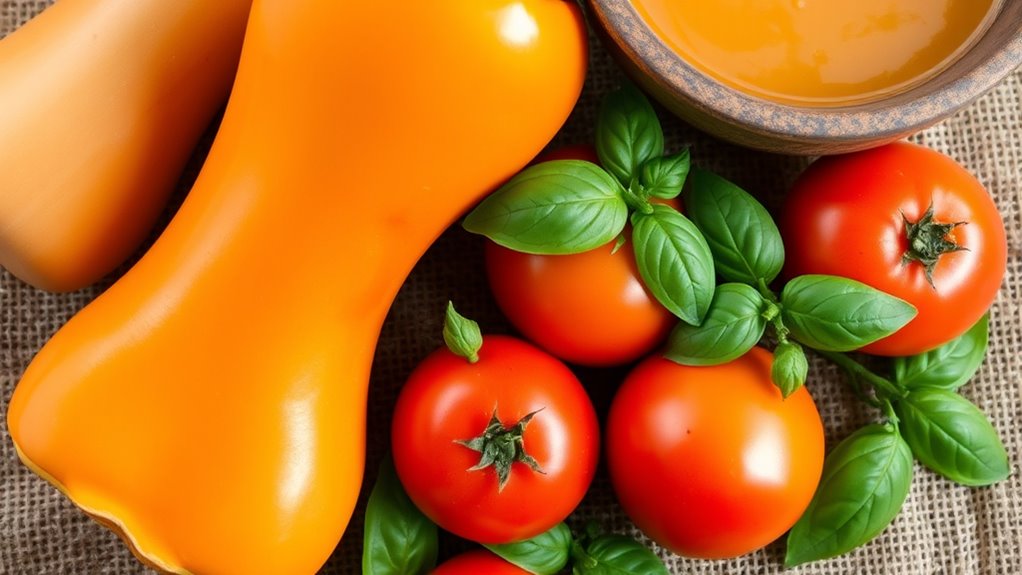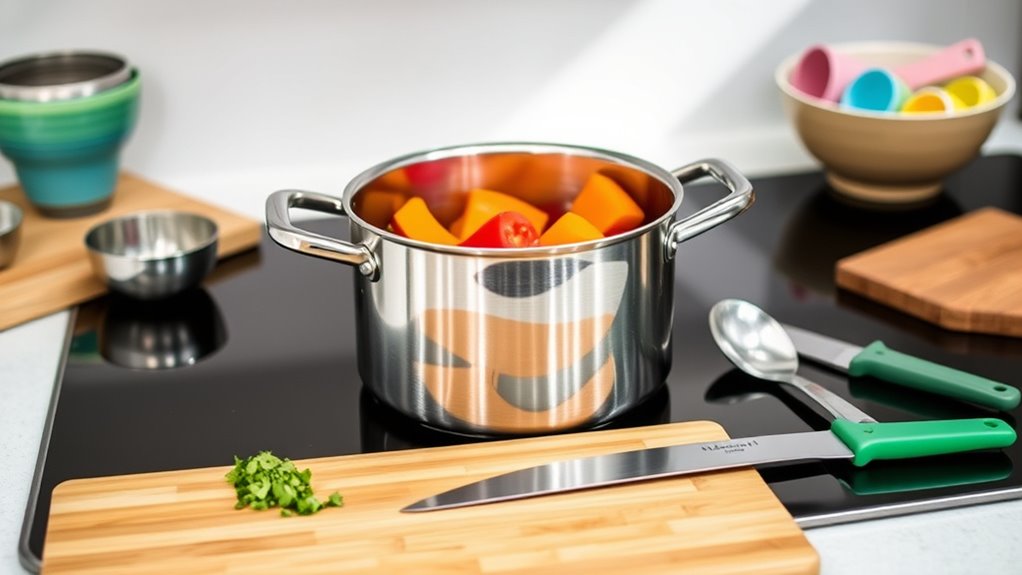This comforting butternut squash tomato soup is silky, savory, and easy to make. You’ll sauté onion and garlic, then fold in cubed squash with crushed tomatoes, plus veg broth for a velvety simmer. A quick blend gives silky texture, or leave it chunky for more bite. Season to taste with salt, pepper, and a hint of thyme or paprika. Serve hot with a splash of cream if you like—and you’ll discover more tweaks if you keep exploring.
Ingredients and Quantity

Gather the ingredients you’ll need for a cozy pot of butternut squash tomato soup. You’ll want a medium butternut squash, diced; crushed tomatoes; onion, garlic, and olive oil for savor; vegetable broth; a pinch of salt and black pepper; a splash of cream or coconut milk; and dried herbs like thyme. Optional: a dash of paprika for warmth. Butternut benefits show up in a creamy texture and balanced sweetness, while nutritional value stays high with fiber, vitamins A and C, and minerals. Use fresh parsley for brightness at the end.
| Ingredient | Quantity | Notes |
|---|---|---|
| Butternut squash | 1 medium | peeled, cubed |
| Crushed tomatoes | 1 can | 28 oz |
| Onion | 1 small | chopped |
Preparations

Now that you’ve lined up the ingredients, it’s time to prep them for a smooth simmer. You’ll trim, peel, and cube squash varieties into even pieces so they cook uniformly, and you’ll crush garlic and chop onions for a quick aroma lift. Pat the vegetables dry to avoid watery temps, then measure spices so nothing surprises you mid-sauté. This prep sets the texture you want, guiding the soup textures toward silk or body, depending on your heat and blending choice.
Prep squash evenly, aromatics ready, spices measured—simmered to silky texture.
- Trim, peel, and cube squash varieties to uniform pieces
- Mince aromatics and measure spices for even flavor
- Sauté briefly, then simmer until vegetables loosen their sweetness
Kitchen tools or Kitchenware Required

A well-planned set of tools makes this soup sing: a sturdy chef’s knife, a large chopping board, and a wide, heavy-bottomed pot or Dutch oven for even heat. You’ll rely on sharp blades, steady cuts, and solid heat retention to guide the flavors from squash to soup with confidence. For prep, a few trusted items keep you nimble: cutting boards (color-coded if you like), a blender you trust for silky texture, and a ladle for portions. Choose blender types that suit your texture preference—immersion for quick blends, countertop for creaminess. Table for quick reference follows.
| Tool | Purpose | Freedom-boosting tip |
|---|---|---|
| Cutting boards | Prep | Protects surfaces and flavors |
| Blender types | Texture control | Pick per batch vibe |
| Heavy pot | Sauté & simmer | Even heat, bold depth |
| Knife | Precision cuts | Sharp edge, safer work |
How to Cook

- Heat a sturdy pot over medium heat and add a splash of oil to release the aromatics’ depth.
- Sauté onions, garlic, and a pinch of salt until golden and fragrant.
- Add the tender squash and tomatoes to the pot, stirring to combine.
- Pour in broth and let the mixture simmer until velvety and well cooked.
- Blend the soup partially or fully, depending on your desired texture.
- Adjust the thickness by adding more liquid and finish with a splash of cream or coconut milk.
- Season the soup in stages, enhancing flavors with spices like cumin, paprika, and thyme for a bright finish.
How to Serve

To serve, ladle the soup into warm bowls, letting its velvet color glow against a neutral plate. You’ll want a simple presentation that respects the soup’s sweetness while inviting aroma and texture. Thick enough to coat the spoon, yet light enough to sip in one mouthful, it pairs with a clean crust of bread or a crisp cracker. Garnish options should be deliberate, not distracting: a drizzle of cream, a scatter of toasted pumpkin seeds, or a pinch of smoked paprika for warmth. Pairing suggestions include a light white wine or a citrusy sparkling water to lift the squash’s sweetness. Serve promptly to retain aroma, then invite your guests to customize with a final pinch of salt and pepper. Enjoy the balance you created.
Tips
Tapping into the plate-ready vibe from serving tips, these practical pointers help you get the most flavor, texture, and aroma from your butternut squash tomato soup. You’ll taste seasonal flavors at their peak, and you’ll feel the soup respond to your choices. Keep the base balanced with a touch of acidity and a gentle sweetness, adjusting with ingredients you already have. When in doubt, lean on confident seasoning and bold aromatics to wake every spoonful.
Tapping into seasonal flavors, balance acidity with gentle sweetness, and finish with bold aromatics for every spoonful.
1) Seasonal flavors first: swap squash or tomato varieties to heighten brightness.
2) Ingredient substitutions: creaminess via coconut milk or yogurt; extra body with a splash of broth.
3) Finish like a pro: a final drizzle of olive oil, herbs, and a pinch of salt.
Food Value and Benefit
Butternut squash and tomatoes combine to create a nutrient-rich dish packed with essential vitamins and minerals. This recipe offers a variety of health benefits, making it a wholesome choice for your meals.
Nutritional Content:
- Rich in fiber, promoting digestive health and improved satiety
- High in vitamin A (from beta-carotene in butternut squash), supporting vision and immune function
- Contains vitamin C (from tomatoes), boosting antioxidant protection and skin health
- Provides potassium, aiding in maintaining healthy blood pressure levels
- Includes lycopene (from tomatoes), known for its heart health benefits and anti-inflammatory properties
Benefits of Eating This Recipe:
- Supports steady energy levels throughout the day
- Enhances immune resilience
- Helps manage hunger and portion control due to high fiber content
- Offers antioxidant protection to combat oxidative stress
- Reduces inflammation, contributing to overall vitality and well-being
- Provides nourishing, practical sustenance suitable for an active and independent lifestyle
Enjoy this flavorful, nutrient-dense soup as a delicious way to support your health and wellness goals.
Frequently Asked Questions
Can I Freeze Leftovers of This Soup?
Yes, you can freeze leftovers. Think of it like saving potential meals for later. Tips for freezing, thawing methods, best storage containers, and practical notes guarantee you stay free and fearless while preserving flavor.
Is It Gluten-Free and Dairy-Free?
Yes, it’s gluten-free and dairy-free as written, so you can savor it freely; just choose gluten alternatives and dairy substitutes you trust, keeping the savory, creamy texture you crave while you design your own dairy-free, gluten-free version.
Can I Use Vegetable Stock Instead of Water?
Yes, you can; using vegetable stock boosts flavor and depth. You’ll savor the vegetable stock benefits as it layers richness, enhances seasoning, and delivers a savory, practical boost that makes your soup taste fuller and more satisfying.
How Long Will It Keep in the Fridge?
Soup storage in the fridge lasts about 3 to 4 days. You’ll savor every bite, but don’t push it—eat within the fridge lifespan. Your freedom-loving palate demands careful cooling and airtight containers for best flavor.
Can I Add Protein to This Soup?
Yes, you can add protein. Try adding beans or using chicken. You’ll savor the savory, hearty boost while keeping it practical and flexible, so you taste freedom with each spoonful as flavors mingle in satisfying harmony.
